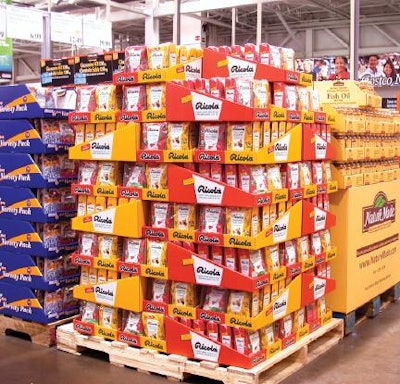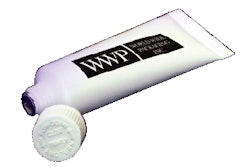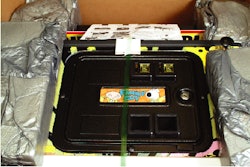
Some marketers contend that packaging should serve as a marketing vehicle and a means of meeting consumers’ needs. Others say that packaging should help differentiate brands to set the stage for consumer brand preferences.
Still other marketers think packaging
should make products easier to find in over-assorted retail
environments. All of these ideas have merit, but present too simple a
view given the complexities of marketing to today’s consumers within
distinctly different retail environments.
Retailers have undergone a marketing transformation. They are now in
the business of building brands. Their own. Retailers’ focus is on
aligning their merchandise mixes: private label as well as national
brands, and the shopping experiences they provide as distinct and
unique; a reflection of strategically developed branding in alignment
with consumer perceptions.
When consumers are scanning retail shelves packed with competitive
choices for a precious few seconds before making a decision,
connections have to be made quickly and convincingly. Pretty product
packaging isn’t sufficient. Great graphics, color, and a strong brand
identity are par for the course in today’s marketplace. Brand packaging
has to be more unique and distinctive in structure or emotional cues to
resonate now. The elements of whimsy, surprise, retro, sensory
stimulation or luxury can be used in packaging to deliver brands to
consumers in more memorable ways.
Tip: Consumers are increasingly exercising control in fashioning their
own experiences. Retailers that deliver the kinds of experiences
consumers are seeking will win in the marketplace.
What consumer research tells us
What kinds of experiences do consumers respond to best? We’ve uncovered
principle consumer drivers in our research. These include: creation of
greater perceived brand value vs. competitors’ brands; clearly
delineated brand differences, with uncomplicated, direct packaging
communication; perceived lifestyle fit; upscale, more luxury-oriented
branding for consumers who have, or aspire to have, more status; and
the delivery of enjoyment assets.
Tip: We humans respond to product brands that deliver enjoyment or
fulfill emotional desires. Brand assets that can be leveraged in
packaging to give consumers pleasure and enjoyment are powerful
purchase motivators—and also repeat purchase motivators. Endeavor to
uncover them.
Consumer drivers must be delivered in package design to play to
consumers’ deepest desires, not only their needs. Think about it. All
consumers need to purchase the basics of life. So why does one
commodity brand outsell another? What drives consumers to find one
shampoo or packaged coffee brand more desirable than another? The
intangible assets around the branded product are the dealmakers or
breakers. These intangibles have to be sold in large part by packaging.
If products fail in the marketplace, brand managers must ask themselves
whether ineffective packaging is a contributing factor. Did consumers
overlook the products because they simply overlooked the packaging? If
packaging isn’t compelling on the shelf, if it doesn’t appeal to
emotions or deeper desires, do consumers have adequate reason to
consider the products?
Packaging in retail context
Retail needs and consumer expectations are increasingly dictating
packaging decisions. Not only must package design consultants research
core brand attributes and leverage those in packaging, they also must
develop it in retail context.
Private-label brands have to differentiate retailers strategically from
competitors in the eyes of consumers by affirming their unique
positioning. Retailers’ private-label brands are competing with
established national brands more than ever before. About one out of
every four products sold in the U.S. is a private-label product.
Packaging for national brands has to be tweaked for various retail
channels. When packaging products for Wal-Mart supercenters or club
stores, the focus is on a price-to-value ratio. Large pack and
multi-pack offerings benefit from the strong use of color and graphics
in palletized, no-frills packaging in club stores. A limited hierarchy
of product information on packaging of this nature, coupled with bold
graphics, wins over the club store consumer. Both consumer and retailer
focus are on highly visible brands at the best prices at Wal-Mart.
Small pack sizes, quality imagery, and communication are geared to sell
brand value rather than price for supermarket and drug chains.
Consumers in these environments are increasingly information hungry.
Where were the products sourced from? Are they quality conscious? Are
they safe? Can they be trusted? Remember that even quality brands have
been compromised due to outsourcing concerns in recent months. Both
retailers and manufacturers need to find ways to communicate this
information satisfactorily to the consumer through on-pack, off-pack,
and in-store measures for both food and non-food brands.
Tip: Within categories, what unique consumer cues can be leveraged on
packaging to make connections with them, avoiding the dreaded commodity
trap in the process?
At the other end of the spectrum, upscale and specialty retailers such
as Fortunoff, REI, and Williams-Sonoma sell lifestyle and luxury
branded products to consumers. In these environments, consumers invest
emotionally both in the shopping experience and in the retail brand
itself.
Upscale packaging delivers emotional assets: a sense of well-being,
enjoyment, and a lifestyle fit—real or aspired—making both the retail
and the product brands deeply satisfying by association. Packaging
employs high-quality visuals, specific cues that point to lifestyle or
luxury, and language conveying the desirability and image of both
product and retail brand.
Tip: Customer-centric service has to be offered at an uncompromising,
high level to seal the deal and the brand image for these retailers’
customers.
Then there is national discounter Target. Because its positioning and
the shopping experience it offers are distinctive, Target commands a
loyal customer following. Interestingly, consumers shop at Target on
price for commodity items, but they also seek lifestyle products filled
with perceived value and emotional appeal. Target offers packaged
consumer products that are aligned with its brand. Wal-Mart will always
win on price. But Target proves that discounters can own distinct brand
identities other than “the lowest price.”
Consumers are clearly in charge and looking for more than features and
benefits in the brands they choose. They’re searching for connections,
making it imperative for retailers to deliver emotionally satisfying
experiences in product brands, packaging and the shopping experience or
face marketplace irrelevance and demise.
Join the conversation: You’re invited to weigh in by sharing your own
experiences and insights on retail packaging issues with Shelf Impact!
readers at [email protected].
The author, Ted Mininni is president of Design Force Inc., a metro New
York consultancy that specializes in brand identity and package design
for the food, beverage, toy, and entertainment industries. Contact Ted
at 856-810-2277 or [email protected].


























